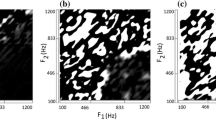Abstract
Recent interest in the occurrence of sleep apnoea has brought about the development of several methods of detecting apnoeas. Complete polygraphic evaluation of sleep involves considerable equipment, expense, and personnel time for the collection and analysis of the data. Not infrequently these results will indicate that a patient has an insufficient number of apnoeic events to clinically impair health, thus yielding little information at great expense. This being the case, an automated method of reliably evaluating patients for sleep apnoea using a minimum of apnoea detection equipment and personnel time would be clinically useful. Such a method has been devised, using tracheal sound as the physiological indicator of apnoea. Treacheal sound is monitored by a microcomputer, which detects periods of low tracheal sound corresponding to a lack of airflow. Periods of low tracheal sound which last 10 s or longer are recorded overnight and stored for review by the user at any time. This tracheal sound method of apnoea detection has been compared with data obtained during polygraphic sleep studies utilising thermistors to detect airflow and an ear oximeter to monitor arterial oxygen saturation. The results compare favorably, and although tracheal sound detection introduces some error into apnoea detection, it can be seen that tracheal sound detection can be a useful screening tool to indicate patients in need of more detailed sleep study.
Similar content being viewed by others
References
Block, A. J., Boysen, P. G., Wynne, J. W. andHunt, L. A. (1979) Sleep apnea, hypopnea, and oxygen desaturation in normal subjects. A strong male predominance.N. Engl. J. Med.,300, 513–517.
Cummiskey, J. M., Williams, T. C., Krumpe, P. E. andGuilleminault, C. (1982) The detection and quantification of sleep apnea by tracheal sound recordings.Am. Rev. Respir. Dis.,126, 221–224.
Guilleminault, C. andDement, W. C. (Eds.) (1978)Sleep apnea syndromes. Kroc Foundation Series, Vol. 11, Alan R. Liss, Inc., New York.
Krumpe, P. E. andCummiskey, J. M. (1980) Use of laryngeal sound recordings to monitor apnea.Am. Rev. Respir. Dis.,122, 797–801.
Rushmer, R. F., Tidwell, R. A. andEllis, R. M. (1954) Sonvelographic recording of murmurs during acute myocarditis.Am. Heart J.,48, 835–846.
Author information
Authors and Affiliations
Rights and permissions
About this article
Cite this article
Peirick, J., Shepard, J.W. Automated apnoea detection by computer: analysis of tracheal breath sounds. Med. Biol. Eng. Comput. 21, 632–635 (1983). https://doi.org/10.1007/BF02442390
Received:
Accepted:
Issue Date:
DOI: https://doi.org/10.1007/BF02442390




